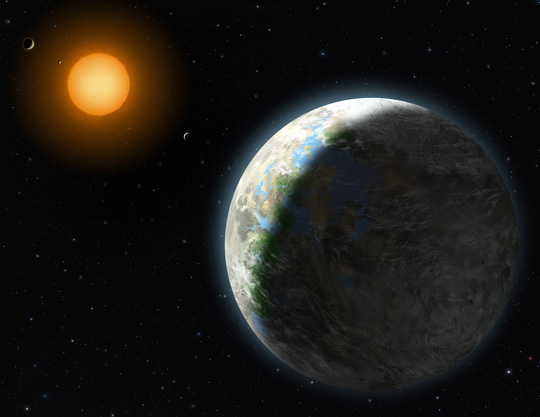 My friends, the revolution has begun.
My friends, the revolution has begun.
Scientists from UC Santa Cruz announced today the discovery of Gliese 581g, the first planet discovered in the habitable zone of its star. Let me repeat: the first planet discovered in the habitable zone of its star.
In this habitable zone, temperatures are just right to support life as we know it here on Earth–that’s why it’s known as the “habitable zone.” Of course, there are several other conditions that need to be met before we can know whether the planet is truly habitable, but one of the most important criteria has already been met.
According to the report, this planet sounds like one of the rainbow worlds from Isaac Asimov’s Foundation trilogy. It’s tidally locked to its star, which means that one side of the planet is always in day, while the other side is always in night. If life as we know it exists on this world, it’s probably limited to the narrow band of twilight between the extremely hot day zone and extremely cold night zone.
The scientists calculate that the planet is about three times as massive as Earth, which means that if it’s a rocky world (as opposed to an ocean world), gravity on the surface would be about 1.2 times that of Earth. The host star, Gliese 581, is only twenty lightyears from Earth–the 86th closest star to our solar system.
But the best part is that the scientists feel that there are many, many more worlds like this out there. They detected Gliese 581g using the radial velocity method, which uses the star’s wobble to detect the planets tugging on it. Typically, this method is only good for discovering “hot jupiters”–very massive gas giants in extremely tight orbits (sometimes with a period of only a few Earth days). However, by the fact that scientists were able to find a planet in the habitable zone using this method, they predict that similar Earth-like planets are extremely common.
That is so cool, I don’t know what to say other than “the revolution has begun.” And truly, it’s a revolution. When we start discovering hundreds of Earth-like planets, and find that several of them have conditions perfect for supporting life (or better yet, actual evidence of life present), it’s going to change everything about how we think of our place in the universe.
This is an incredibly exciting time to be alive! Now if only I could live long enough to join the first colonization mission to one of these worlds…
Dang, that’s awesome! Of course it’s too soon to be *too* excited, but that’s great there’s still progress being made in space exploration.
Wow.
That is amazing…
I don’t know why this is such big news. Back in 1996, a team at Palo Alto found something much more significant:
http://www.theonion.com/articles/new-solar-system-discovered-four-feet-from-earth,1094/